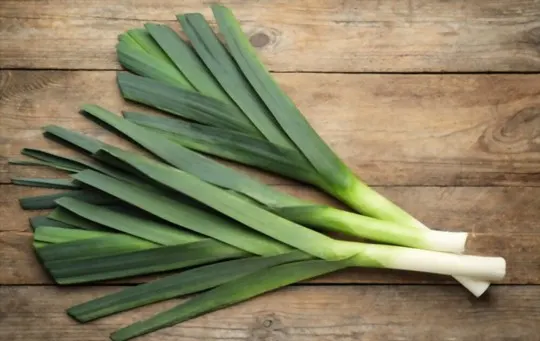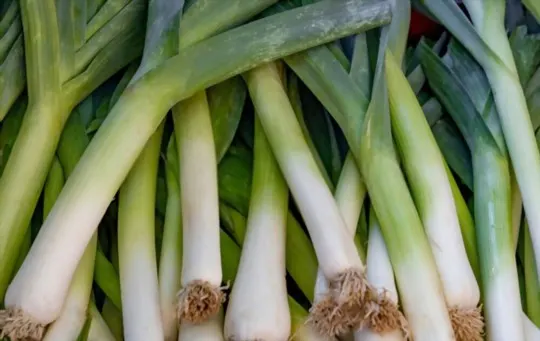We know you care about the food you put in your stomach, which is why we want to give you all the details on how long leeks last and if they go bad.
Leeks are a versatile winter vegetable with a mild onion-like flavor and can be used in soups, quiches, casseroles, and more!
But do you ever find yourself wondering how long they will keep their optimum flavor?
We get it – there’s nothing worse than pulling out an ingredient from your fridge only to realize that it has gone off.
So let us alleviate some of your worries; this blog post will answer every question around keeping leeks fresh from lengths of storage periods to signs that tell it’s time for them to go.
By the end of this post, you’ll be able to determine with confidence when to use or discard leeks depending on their condition!
What are Leeks?

Leeks are a type of onion that have a milder flavor than most onions.
They are often used in soups and stews and can be eaten raw or cooked.
Leeks are a good source of vitamins A, C, and K as well as fiber and minerals.
Leeks belong to the Allium family which also includes onions, garlic, chives, and shallots.
They are thought to have originated in Central Asia but are now grown all over the world.
The part of the leek that is typically eaten is the white base and light green stalk.
The leaves of the leek are tough and bitter and are not usually eaten.
Leeks have a mild onion flavor that is sweeter than most onions.
They can be eaten raw or cooked and are often used in soups and stews.
When cooking leeks, it is important to clean them well since they tend to be sandy.
To clean a leek, cut off the root end and the dark green leaves.
Slice the leek in half lengthwise and then rinse under running water to remove any sand or dirt.
How to Store Leeks?
Leeks are a type of onion that is related to garlic, shallots, and scallions.
They have a milder flavor than most onions and are often used in soups, stews, and other dishes.
Leeks can be stored in a number of different ways, depending on how long you want them to last.
If you plan on using the leeks within a week, they can be stored in the refrigerator.
Place them in a plastic bag or container with holes so that they can breath.
Leeks will last up to seven days when stored this way.
If you want them to last longer, leeks can also be frozen.
Cut off the root end and green leaves and wash the leek well.
slice the leek into thin pieces or chop it up before freezing.
Frozen leeks will last for several months. You can also pickle leeks to extend their shelf life.
Pickled leeks will last for several months when stored in the refrigerator.
To pickle leeks, slice them into thin pieces and place them in a jar or container.
Cover the leeks with vinegar or brine and seal the container.
Store pickled leeks in the refrigerator and enjoy them as a side dish or condiment.
How Long Do Leeks Last?

Leeks are a type of vegetable that have a mild and slightly sweet taste.
They can be used in both cooked and raw recipes to add delicious flavor.
An advantage to using leeks is that it can last for several days when properly stored in the refrigerator.
If they are kept in the original packaging and wrapped with plastic wrap, they should remain fresh up to five days.
For longer shelf life, they can also be blanched to help them stay fresh for between one to two months.
Although leeks can last for long periods of time, it’s still important to check them regularly for signs of spoilage and avoid using fan leaves or stalks that appear dried out or soggy.
Storing them correctly will ensure you enjoy their full nutritional benefits and optimal taste in your cooking needs.
Can You Freeze Leeks?
Can you freeze leeks? The answer is yes, you can.
Leeks are a great vegetable to have on hand in the freezer because they last a long time and are still usable even after being frozen.
Here are some tips for freezing leeks:
- Cut the leeks into thin slices before freezing them. This will help them thaw more quickly and evenly.
- Place the sliced leeks in a single layer on a baking sheet and put them in the freezer. Once they are frozen solid, transfer them to a freezer bag or container.
- Label the freezer bag or container with the date so you know how long they have been in there. Leeks will be good for up to 12 months in the freezer.
When you’re ready to use the frozen leeks, there’s no need to thaw them first.
Just add them straight from the freezer to whatever dish you’re making.
They may not be as crisp as fresh leeks, but they will still add flavor and texture to your dish.
How to Tell If Leeks are Bad?

If you’re not sure whether your leeks have gone bad, there are a few things you can look for.
First, check the color of the leeks. They should be white or light green; if they’re anything else, they’re probably past their prime.
Second, smell the leeks. They should smell fresh; if they have any other odor, they’re likely starting to go bad.
Finally, feel the leeks. They should be firm to the touch; if they’re mushy, they’ve probably gone bad.
If any of these things are true of your leeks, it’s best to throw them out and get fresh ones.
Leeks can go bad pretty quickly, so it’s important to use them as soon as possible after you buy them.
With that said, properly stored leeks can last up to two weeks in the fridge.
So if you’re not going to use them right away, make sure to store them properly.
Conclusion
In conclusion, leeks are a great veggie to have on hand.
They last a long time, so you don’t have to worry about them going bad anytime soon.
You can also freeze them if you want to extend their shelf life.
And if you’re ever unsure about whether or not your leeks are still good, there are a few telltale signs to look out for.

How Long Do Leeks Last? Do They Go Bad?
Ingredients
- Leeks
- Air-tight containers or Ziplock bags
- Labels and markers
Instructions
- Store your product in an labelled container in a cool, dark place like the pantry or fridge.
- If your food is frozen, allow it to thaw in the fridge before cooking.
- Make sure to look for signs that your food has gone bad before eating it.

Carrie is a food writer and editor with more than 15 years of experience. She has worked for some of the biggest names in the food industry, including Bon Appétit, Food & Wine, and Martha Stewart Living.
As the Editor in Chief of IntroChicago.com, Carrie oversees all of the content on the site. She also manages the team of contributing writers and editors, who help to create delicious recipes, helpful tips, and informative articles that you’ll find on the site.
A native of the Chicago area, Carrie is passionate about all things food. She loves trying new restaurants and experimenting with new recipes in her kitchen. She’s also a graduate of the Culinary Institute of America, so she knows a thing or two about food!
